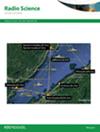Stochastic analysis of epithelial/absorbed power density in multilayered planar skin model with uncertain tissue electric properties
IF 1.6
4区 地球科学
Q3 ASTRONOMY & ASTROPHYSICS
引用次数: 0
Abstract
Stochastic analysis of the absorbed power density (APD) on skin surface exposed to radiation of halfwave dipole at 10, 30 and 90 GHz and for different antenna-body distances is presented. Skin tissue is modeled as a half-space consisting of one layer (skin) or three layers (skin, fat and muscle) whose permittivities and conductivities are uncertain. Deterministic part is based on numerical solution of Pocklington equation via Galerkin Bubnov Indirect Boundary Element method (GB-IBEM) and numerical integration of the corresponding field integrals. Uncertainty from tissue electric parameters is propagated to APD via nonintrusive Stochastic Collocation method (SCM) in order to compute stochastic moments of APD. For 1-layered model APD stochastic moments are computed with 3 deterministic simulations. On the other hand APD mean and variance for 3 layered model are successfully computed with 13 deterministic simulations while skewness and kurtosis require 85 deterministic simulations. The ratio of APD standard deviation and mean decreases with frequency thus indicating that the uncertainty in the tissue electric properties has smaller effect on APD uncertainty at higher frequencies. Finally, sensitivity analysis carried out for both 1-layered and 3-layered models indicates the same conclusions. At 10 GHz skin permittivity and conductivity are the two most important parameters. However, as frequency increases the impact of skin conductivity prevails. This indicates that in frequency range 10-90 GHz the APD uncertainty quantification and sensitivity analysis can be carried out by using only 2-dimensional stochastic model.具有不确定组织电特性的多层平面皮肤模型中上皮/吸收功率密度的随机分析
本文对暴露在 10、30 和 90 千兆赫半波偶极子辐射下的皮肤表面的吸收功率密度(APD)进行了随机分析,并对不同的天线-身体距离进行了分析。皮肤组织被模拟为由一层(皮肤)或三层(皮肤、脂肪和肌肉)组成的半空间,其介电常数和电导率是不确定的。确定性部分基于通过 Galerkin Bubnov 间接边界元素法(GB-IBEM)对 Pocklington 方程的数值求解,以及相应场积分的数值积分。组织电参数的不确定性通过非侵入式随机配位法(SCM)传播到 APD,以计算 APD 的随机矩。对于单层模型,通过 3 次确定性模拟计算 APD 随机矩。另一方面,3 层模型的 APD 平均值和方差只需 13 次确定性模拟即可成功计算,而偏度和峰度则需要 85 次确定性模拟。APD 标准偏差和平均值的比值随频率的增加而减小,这表明组织电特性的不确定性对高频率 APD 不确定性的影响较小。最后,对 1 层和 3 层模型进行的敏感性分析表明了相同的结论。在 10 GHz 时,皮肤介电常数和电导率是两个最重要的参数。然而,随着频率的增加,表皮电导率的影响占了上风。这表明,在 10-90 GHz 频率范围内,只需使用二维随机模型即可进行 APD 不确定性量化和灵敏度分析。
本文章由计算机程序翻译,如有差异,请以英文原文为准。
求助全文
约1分钟内获得全文
求助全文
来源期刊

Radio Science
工程技术-地球化学与地球物理
CiteScore
3.30
自引率
12.50%
发文量
112
审稿时长
1 months
期刊介绍:
Radio Science (RDS) publishes original scientific contributions on radio-frequency electromagnetic-propagation and its applications. Contributions covering measurement, modelling, prediction and forecasting techniques pertinent to fields and waves - including antennas, signals and systems, the terrestrial and space environment and radio propagation problems in radio astronomy - are welcome. Contributions may address propagation through, interaction with, and remote sensing of structures, geophysical media, plasmas, and materials, as well as the application of radio frequency electromagnetic techniques to remote sensing of the Earth and other bodies in the solar system.
 求助内容:
求助内容: 应助结果提醒方式:
应助结果提醒方式:


